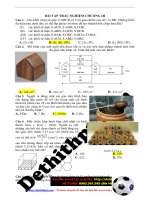Đề 45 image marked image marked
Bạn đang xem bản rút gọn của tài liệu. Xem và tải ngay bản đầy đủ của tài liệu tại đây (1.31 MB, 7 trang )
Exercise 45:
Read the following passage and mark the letter A, B, C or D to indicate the correct answer to each
of the questions.
Tulips are Old World, rather than New World, plants,
with the origins of the species lying in Central Asia. They
became an integral part of the gardens of the Ottoman
Empire from the sixteenth century onward, and, soon after,
part of European life as well. Holland, in particular, became
famous for its cultivation of the flowers.
A tenuous line marked the advance of the tulip to the
New World, where it was unknown in the wild. The first
Dutch colonies in North America had been established in
New Netherlands by the Dutch West India Company in 1624, and one individual who settled in New
Amsterdam (today's Manhattan section of New York City) in 1642 described the flowers that bravely
colonized the settlers' gardens. They were the same flowers seen in Dutch still-life paintings of the time:
crown imperials, roses, carnations, and of course tulips. They flurished in Pennsylvania too, where in
1698 William Penn received a report of John Tateham's "Great and Stately Palace," its garden full of
tulips. By 1760, Boston newspapers were advertising 50 different kinds of mixed tulip "roots." But the
length of the journey between Europe and North America created many difficulties. Thomas Hancock, an
English settler, wrote thanking his plant supplier for a gift of some tulip bulbs from England, but his letter
the following year grumbled that they were all dead.
Đăng ký file Word tại link sau
/>
Tulips arrived in Holland, Michigan, with a later wave of early nineteenth-century Dutch
immigrants who quickly colonized the plains of Michigan. Together with many other Dutch settlements,
such astheone at Pella, Iowa, they established a regular demand for European plants. The demand was
bravely met by a new kind of tulip entrepreneur, the traveling salesperson. One Dutchman, Hendrick van
de Schoot, spent six months in 1849 traveling through the United States taking orders for tulip bulbs.
While tulip bulbs were traveling from Europe to the United States to satisfy the nostalgic longings of
homesick English and Dutch settlers, North American plants were traveling in the opposite direction. In
England, the enthusiasm for American plants was one reason why tulips dropped out of fashion in the
gardens of the rich and famous.
Trang 1
QUESTION
Question 1: Which of the following questions does the passage mainly answer?
A. What is the difference between an Old World and a New World plant?
B. How did tulips become popular in North America?
C. Where were the fist Dutch colonies in North America located?
D. Why are tulips grown in many different parts of the world?
Question 2: The word "integral" in paragraph 1 is closest in meaning to _____.
A. overlooked
B. ornamental
C. fundamental
D. interesting
Question 3: The passage mentions that tulips were fist found in which of the following regions?
A. India
B. Western Europe
C. North America
D. Central Asia
Question 4: The word "flurished" in paragraph 2 is closest in meaning to ______.
A. were marketed
B. thrived
C. combined
D. were discovered
Question 5: The author mentions tulip growing in New Netherlands, Pennsylvania and Michigan in order
to illustrate how ______
A. tulips were commonly passed as gifts from one family to another
B. attitudes toward tulips varied from one location to another
C. imported tulips were considered more valuable than locally grown tulips
D. tulips grew progressively more popular in North America
Question 6: The word "grumbled" at the end of paragraph 2 is closest in meaning to __________.
A.warned
B. complained
C. explained
D. denied
Question 7: The passage mentions that one reason English and Dutch settlers planted tulips in their
gardens was that tulips _________.
A. made them appear fashionable
B. reminded them of home
C. were easy to grow
D. had become readily available
Question 8: The word "they" in paragraph 3 refers to _________________.
A. tulips
B. plains
C. immigrants
D. plants
Trang 2
Question 9: According to the passage, which of the following changes occurred in English gardens
during the European settlement of North America?
A. They contained a wider variety of tulips than ever before.
B. They grew in size in order to provide enough plants to export to the New World.
C. They contained many new types of North American plants.
D. They decreased in size on the estates of wealthy people.
Question 10: The passage mentions which of the following as a problem associated with the importation
of tulips into North America?
A. Settlers knew little about how to cultivate them.
B. They were no longer fashionable by the time they arrived.
C. Orders often took six months or longer to fit.
D. They often failed to survive the journey.
GIẢI CHI TIẾT
Question 1: Which of the following questions does the passage mainly answer?
A. What is the difference between an Old World and a New World plant?
B. How did tulips become popular in North America?
C. Where were the fist Dutch colonies in North America located?
D. Why are tulips grown in many different parts of the world?
Dịch nghĩa: Đoạn văn trả lời câu hỏi nào dưới đây?
A. Sự khác biệt giữa thế giới cũ và mới là gì?
B. Hoa tulip đã trở nên thịnh hành ở Bắc Mỹ như thế nào?
C. Thuộc địa Hà Lan đầu tiên ở Mỹ được đặt ở đâu ?
D. Tại sao hoa Tulip được trồng ở nhiều nơi khác nhau trên thế giới?
Giải thích: Ta thấy câu chủ đề của đoạn 2: "A tenuous line marked the advance of the tulip to the New
World..."-"Một ranh giới mỏng manh đã đánh dấu sự xuất hiện của hoa tulip ở thế giới mới..."
Thế giới mới ở đây chính là Bắc Mỹ. Sau đó tác giả lần lượt miêu tả sự phổ biến rộng rãi của tulip ra
khắp nước Mỹ
Question 2: The word "integral" in paragraph 1 is closest in meaning to _____.
A. overlooked
B. ornamental
C. fundamental
D. interesting
Dịch nghĩa: Từ "intergral" trong đoạn 1 gần nghĩa nhất với ____________
A. bị bỏ sót
B. mang tính trang trí
C. thiết yết
D. thú vị
Trang 3
Giải thích: Ta có: (to) be intergral = (to) be fundamental: thiết yếu, quan trọng
Question 3: The passage mentions that tulips were fist found in which of the following regions?
A. India
B. Western Europe
C. North America
D. Central Asia
Dịch nghĩa: Đoạn văn đề cập đến hoa tulip được tìm thấy đầu tiên ở vùng nào?
A. Ấn Độ
B. Tây Âu
C. Bắc Mỹ
D. Trung Á
Giải thích: Đọc câu đầu đoạn văn: "Tulips are old world, rather than new world, plants, with the origins
of the species lying in Central Asia" - "Tulip là loài cây thuộc thế giới cũ, hơn là thế giới mới, với nguồn
gốc của loài này nằm ở trung Á."
Question 4: The word "flurished" in paragraph 2 is closest in meaning to ______.
A. were marketed
B. thrived
C. combined
D. were discovered
Dịch nghĩa: Từ "flurished" trong đoạn 2 gần nghĩa nhất với ____________.
A. đã được tung ra thị trường
B. phát triển nở rộ
C. được kết hợp
D. được tìm thấy
Giải thích: Ta có: (to) flurish = (to) thrive: phát triển nở rộ
Question 5: The author mentions tulip growing in New Netherlands, Pennsylvania and Michigan in order
to illustrate how ______
A. tulips were commonly passed as gifts from one family to another
B. attitudes toward tulips varied from one location to another
C. imported tulips were considered more valuable than locally grown tulips
D. tulips grew progressively more popular in North America
Dịch nghĩa: Tác giả đề cập tulip được trồng ở New Netherlands, Pennsylvania và Michigan để minh họa
___________________.
A. tulip đã được truyền từ gia đình này sang gia đình khác như thế nào
B. thái độ đối với hoa tulip khác nhau thế nào từ vùng này sang vùng khác
C. hoa tulip nhập khẩu được đánh giá cao hơn hoa địa phương như thế nào
D. hoa tulip dần trở nên phổ biến hơn ở Bắc Mỹ như thế nào
Giải thích: Đọc bài ta thấy tác giả nói đến sự phổ biến rộng rãi của hoa tulip ở New Netherlands,
Pennsylvania và Michigan., là để thể hiện sự phát triển của hoa tulip ở Bắc Mỹ đã ngày càng rộng ra.
Question 6: The word "grumbled" at the end of paragraph 2 is closest in meaning to __________.
Trang 4
A.warned
B. complained
C. explained
D. denied
Dịch nghĩa: Từ "grumbled" ở cuối đoạn 2 gần nghĩa nhất với___________,
A cảnh cáo
B. phàn nàn
c. giải thích
D. từ chối
Giải thích: Ta có: (to) grumble = (to) complain: phàn nàn, càu nhàu về vấn đề gì
Question 7: The passage mentions that one reason English and Dutch settlers planted tulips in their
gardens was that tulips _________.
A. made them appear fashionable
B. reminded them of home
C. were easy to grow
D. had become readily available
Dịch nghĩa: Đoạn văn nói đến 1 lý do tại sao người Anh và Hà Lan
trồng tulip trong vườn của họ là vì tulip
.
A. làm cho họ có vẻ thời thượng
B. nhắc nhở họ về quê nhà
C. rất dễ trồng
D. đã trở nên sẵn có
Giải thích: Đọc dòng 8 từ dưới lên đoạn cuối: "While tulip bulbs were travelling for Europe to the United
States to satisfy the nostalgic longings of homesick English and Dutch settlers..." - "Khi những nụ tulip
đang đi từ châu Âu đến Mỹ để thỏa mãn sự mong đợi cố hương của những người Anh và Hà Lan..."
Như vậy có thể hiểu những bông hoa tulip được trồng là để nhắc người nhập cư châu Âu về quê hương
của họ.
Question 8: The word "they" in paragraph 3 refers to _________________.
A. tulips
B. plains
C. immigrants
D. plants
Dịch nghĩa: Từ "they" ở doạn 3 nói đến ________.
A. tulip
B. thảo nguyên
C người nhập cư
D. cây cối
Giải thích: Đọc câu đầu đoạn cuối bài viết:"... Dutch immigrants who quickly colonized the plains of
Michigan. Together with many other Dutch settlements, such as the one at Pella, Iowa, they established a
regular demand for European plants."-"...người nhập cư Hà Lan sau đó của đầu thế kỉ 19, những người
nhanh chóng thống trị những thảo nguyên Michigan. Cùng với những sự di cư khác từ Hà Lan, như ở
Pella, Iowa, họ tạo nên một nhu cầu thường xuyên cho những loại cây từ Châu Âu."
"they" ở đây là nói đến những người nhập cư từ Hà Lan và Châu Âu
Trang 5
Question 9: According to the passage, which of the following changes occurred in English gardens
during the European settlement of North America?
A. They contained a wider variety of tulips than ever before.
B. They grew in size in order to provide enough plants to export to the New World.
C. They contained many new types of North American plants.
D. They decreased in size on the estates of wealthy people.
Dịch nghĩa: Theo bài viết, những thay đổi nào sau đây xảy ra ở vườn của người Anh trong quá trình định
cư của người châu Âu ở Bắc Mỹ
A. Chúng gồm có nhiều loại tulip hơn trước đây.
B. Chúng lớn lên về kích cỡ để cung cấp đủ cây để xuất khẩu đến thế giới mới.
C. Chúng bao gồm nhiều loại cây Bắc Mỹ.
D. Chúng giảm về kích cỡ trong những điền sản của người giàu có.
Giải thích: Ta đọc câu cuối bài viết... tulip trở nên lỗi mốt trong những khu vườn của người giàu có và
nổi tiếng". Từ "they" trong các phương án A, B, c, D chỉ "English gardens" (những khu vườn của người
Anh) chứ không phải "khu vực trồng tulip". Vì vậy sự khao khát những loại cây châu Mĩ đã dẫn đến việc
những khu vườn của người Anh trồng nhiều loại cây Bắc Mĩ.
Đáp án C.
Question 10: The passage mentions which of the following as a problem associated with the importation
of tulips into North America?
A. Settlers knew little about how to cultivate them.
B. They were no longer fashionable by the time they arrived.
C. Orders often took six months or longer to fit.
D. They often failed to survive the journey.
Dịch nghĩa: Bài viết đề cập đến cái nào sau đây như một vấn đề liên quan đến sự nhập khẩu tulip vào
Bắc Mỹ?
A. Những người định cư biết rất ít về cách trồng chúng.
B. Chúng không còn thịnh hành vào lúc chúng được nhập khẩu.
C. Những đơn hàng thường tốn 6 tháng hoặc hơn để thực hiện.
D. Chúng thường không thể tồn tại trong chuyến đi.
Giải thích: Đọc dòng 5 từ dưới lên của đoạn 2 ta thấy: "But the length of the journey between Europe
and North America created many diffilties. Thomas Hancock, an English settler, wrote thanking his
plant supplier for a gift of some tulip bulbs from England, but his letter the following year grumbled that
they were all dead"-"Nhưng chuyến đi giữa châu Âu và Bắc Mỹ đã gây nhiều khó khăn. Thomas
Trang 6
Hancock, một người di cư từ Anh, đã viết thư cảm ơn nhà cung cấp cây của ông ấy về món quà là một vài
nụ hoa tulip từ Anh, nhưng lá thư của ông ấy năm sau đó đã phàn nàn rằng chúng đã chết."
Vậy có thể hiểu là hoa tulip đã không thể sống sót trong chuyến đi.
DỊCH BÀI
Tulip là loài cây thuộc thế giới cũ, thay vì là thế giới mới, với nguồn gốc của loài này nằm ở trung
Á. Chúng trở thành một phần thiết yếu trong những khu vườn của đế chế Ottoman từ thế kỉ 16 trở đi, và,
ngay sau đó, một phần của cuộc sống châu Âu. Hà Lan, đặc biệt đã trở nên nổi tiếng vì trồng loại hoa này.
Một ranh giới mỏng manh đánh dấu việc tulip đến thế giới mới, nơi mà chúng không được biết đến
trong thế giới hoang dã. Những thuộc địa đầu tiên của Hà Lan ở Bắc Mỹ đã được lập nên ở New
Netherlands bởi công ty Tây Ấn Hà Lan vào năm 1624, và một người sống ở New Amsterdam (Phần
Mahattan của New York ngày nay) năm 1624 miêu tả loài hoa đã thống trị một cách mạnh mẽ những khu
vườn của người định cư. Chúng giống như những bông hoa trên những bức tranh sống động của Hà Lan:
theo thời gian vương miện hoàng đế, hoa hồng, hoa cẩm chướng, và tất nhiên là tulip. Chúng cũng nở rộ ở
Pennsylvania, nơi mà năm 1698 William Penn đã nhận được một báo cáo từ "cung điện lớn và mang tầm
bang" của John Tateham, khu vườn đầy hoa tulip. Năm 1760, những tờ báo ở Boston đã quảng cáo 50
loại rễ tulip khác nhau. Nhưng khoảng cách của chuyến đi giữa châu Âu và Bắc Mỹ đã gây nhiều khó
khăn. Thomas Hancock, một người di cư từ Anh, đã viết thư cảm
ơn nhà cung cấp cây của ông ấy về món quà một bài nụ hoa tulip
từ Anh, nhưng lá thư của ông ấy năm sau đó đã phàn nàn rằng
chúng đã chết.
Tulip đến Hà Lan, Michigan, với một làn sóng người nhập cư
Hà Lan sau đó của đầu thế kỉ 19, những người nhanh chóng thống
trị những thảo nguyên Michigan. Cùng với những sự di cư khác
của người Hà Lan, như cái ở Pella, Iowa, họ tạo nên một nhu cầu
thường xuyên cho những loại cây từ Châu Âu. Nhu cầu đó đã được
đáp ứng bởi một kiểu mua bán tulip khác, người bán hàng xách
tay. Một người Hà Lan, Hendrick van de Schoot, đã dành 6 tháng
năm 1849 đi khắp nước Mỹ đặt hàng nụ tulip. Khi những nụ tulip
đang đi từ châu Âu đến Mỹ để thỏa mãn sự mong đợi hoài niệm
của những người Anh và Hà Lan nhớ quê hương, những loại cây ở
Bắc Mỹ đang đi với chiều ngược lại. Ở Anh, sự khao khát những
loại cây châu Mỹ là một lí do tại sao tulip trở nên lỗi mốt trong
những khu vườn của người giàu có và nổi tiếng.
Trang 7









